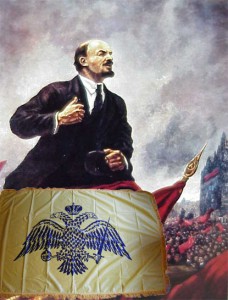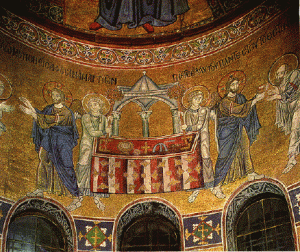 Drew asks if we can consider the Soviet Empire as a continuation of Byzantium. It’s well known that Moscow at one time considered itself as the ‘third Rome’ (or second Constantinople). There were some compelling reasons to think this. Moscow was originally built on seven hills like Rome and Constantinople, Russian troops had been serving in the Byzantine army since the 10th century, and the Russian alphabet, Orthodoxy, and (to some degree) culture had been provided by Byzantium. When Ivan III married Sophia Paleologus- the niece of the last Byzantine emperor- he had a strong claim to be the legitimate heir to the Roman Empire.
Drew asks if we can consider the Soviet Empire as a continuation of Byzantium. It’s well known that Moscow at one time considered itself as the ‘third Rome’ (or second Constantinople). There were some compelling reasons to think this. Moscow was originally built on seven hills like Rome and Constantinople, Russian troops had been serving in the Byzantine army since the 10th century, and the Russian alphabet, Orthodoxy, and (to some degree) culture had been provided by Byzantium. When Ivan III married Sophia Paleologus- the niece of the last Byzantine emperor- he had a strong claim to be the legitimate heir to the Roman Empire.
Setting aside Ivan for a moment, we can dismiss the Soviet Empire entirely. It was a reaction against the very institutions which drew their inspiration from Byzantium. It replaced Orthodoxy with its own saints- Marx, Lenin, Stalin, etc- and did away with the traditional and political underpinnings of the Tsardom.
A better case can be made that the Russian Revolution of 1917 ended Byzantium, but there are still some serious problems with this. For all of the similarities the Russian Empire was a unique entity. They added their own influences into the mix and ultimately drew their inspiration from the Slavic world not the Greek one. More importantly, they didn’t think of themselves as a continuation so much as use imperial Byzantine symbols to legitimize their own rule. Ivan wrapped himself in the double eagle because it added to his prestige, not because he thought of himself as a new Constantine. He was more interested in keeping Ivan alive (and in power) than in resuscitating Byzantium. Constantinople was only important so far as it aided that goal.
A case in point is the 2009 Russian video “Death of an Empire: the Byzantine Lesson” which is narrated by Vladimir Putin’s father-confessor. (you can watch the entire thing on youtube) The film draws a parallel between Byzantium and Russia and the message is that the West is not to be trusted. The Byzantine Empire is pressed into service as a surrogate Russia, and its fall is a warning not to fall into the debt of the West. But the narrator’s call is not to restore Byzantium, it is to restore the Orthodox Russian Empire; an entity not a successor.

St. Sophia of Kiev
Jack asks how close early Russian culture was to Byzantine culture.
The Rus had contact with Constantinople at least as early as the 830’s, but the close ties began with the Rus adoption of Christianity in 989. As always with Byzantine policy, Christianity was the main vehicle for the transmission of culture. The first cathedrals in Russia were built by imported Byzantine architects and they were decorated by imperial artisans. St. Sophia of Kiev, the premier Rus architectural achievement of the 11th century, was modeled on the Hagia Sophia and its metropolitan was subordinated to the Patriarch of Constantinople. By the 1040’s a Byzantine traveler to Kiev would have found it at least visually familiar.
But Russian culture was never a simple copy of Byzantium. It took centuries for Christianity to spread across the vast Rus lands and only a select part of Byzantium was absorbed. For instance, although the Bible was rendered into Old Church Slavonic there is no evidence that any of the Greek treatises on philosophy, mathematics, or science were translated. In other words, the Rus were only interested in some aspects of imperial culture- mostly the magnificent pageantry. The divine liturgy was imported along with the dress and trappings of the court, but the literature was passed up. By the end of the 11th century Constantinople’s pull was beginning to wane and then in 1236 with the invasion of the Golden Horde Russia was wrenched firmly into the Mongolian orbit.
 Joshua asks if the Rus contributed to the economic rise of Byzantium in the 9th and 10th centuries.
Joshua asks if the Rus contributed to the economic rise of Byzantium in the 9th and 10th centuries.
One of the great mysteries in Byzantine history is where exactly the empire got its wealth in the 9th century. As early as the reign of Justinian it was chronically short of funds and even sensible attempts to cut costs got more than one emperor dethroned. By the 8th century Byzantium was clearly heading towards a financial collapse. Plagues and wars had crippled the economy reducing some areas to the barter system and the Islamic invasions had stripped away its most profitable territories.
But as the 9th century rolled around, instead of bankruptcy, the imperial treasury started flinging gold around like it was going out of style. The emperor Theophilus (829-842) built a grand new throne room complete with golden throne, golden lion statues (who could roar at the pull of a lever), and a golden, jewel encrusted tree complete with mechanical birds. When it came time to conclude a truce with the Saracens, he offered 100,000 gold coins- then to impress the Caliph he had his diplomats scatter 36,000 more in the streets of Baghdad.
So where did all this wealth come from? The traditional answer is that new gold mines were discovered- the fabled lost mines of Theophilus. Even though no surviving records mention any such thing, it could certainly be true- mining is a rather dull activity to report on and we have relatively few contemporary sources. But I think there is a case to be made that the Black Sea trade was able to offset the loss of Egypt and North Africa.
The problem is that the Byzantines are frustratingly quiet when it comes to the Rus. Going by Constantinople you would hardly even know they had any dealings with the Russians at all. In the Greek sources there is a grand total of one mention of trade with the Rus- Leo the Deacon reported that in 971 they demanded increased trading rights in exchange for peace. Fortunately for us the Russians kept records- The Russian Primary Chronicle- and it reveals a rich exchange. The general pattern was for the Rus to attack every time they wanted to renegotiate a treaty. In 907, 945, 971, and 988 Constantinople was attacked to force an increase in rights. By the end of the 10th century Rus merchants could stay inside the city for 6 months (instead of the traditional 3) during which time they were given free board, access to baths, and a small stipend courtesy of the emperor.
The main value of the Rus was not what they could directly supply- mostly wax, furs, and slaves- it was their access to the lucrative trade routes through Central Asia, Iran, and Mesopotamia via the Don and Volga rivers. During periods of hostility between the empire and the Caliphate, Asian goods (glassworks and silks) could still reach Constantinople via the Black Sea- during the peak times in Spring and Summer a ship could cross from the Crimea to the Hellespont in 24 hours. Imperial tax collectors took a ten percent toll of everything that entered Constantinople, a massive economic windfall that showed no sign of slowing for several centuries.
No wonder the Byzantines were so reluctant to concede more privileges to the Rus without a war- or to discuss it afterwards!
 Drew asks if we can consider the Soviet Empire as a continuation of Byzantium. It’s well known that Moscow at one time considered itself as the ‘third Rome’ (or second Constantinople). There were some compelling reasons to think this. Moscow was originally built on seven hills like Rome and Constantinople, Russian troops had been serving in the Byzantine army since the 10th century, and the Russian alphabet, Orthodoxy, and (to some degree) culture had been provided by Byzantium. When Ivan III married Sophia Paleologus- the niece of the last Byzantine emperor- he had a strong claim to be the legitimate heir to the Roman Empire.
Drew asks if we can consider the Soviet Empire as a continuation of Byzantium. It’s well known that Moscow at one time considered itself as the ‘third Rome’ (or second Constantinople). There were some compelling reasons to think this. Moscow was originally built on seven hills like Rome and Constantinople, Russian troops had been serving in the Byzantine army since the 10th century, and the Russian alphabet, Orthodoxy, and (to some degree) culture had been provided by Byzantium. When Ivan III married Sophia Paleologus- the niece of the last Byzantine emperor- he had a strong claim to be the legitimate heir to the Roman Empire.
